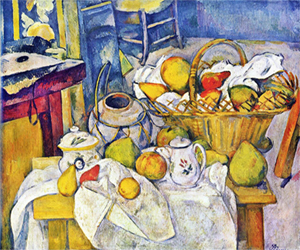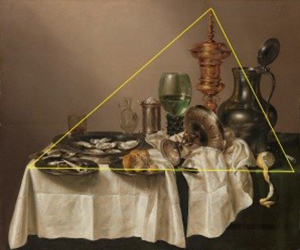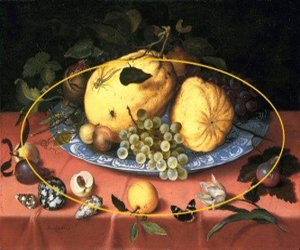MORE CREDIT FOR STILL LIFE?
the world behind the objects is more than a first glance
AN INTRODUCTION.
Within the history of art, still-life has a long line covered. Although still-life, as we know it now, mostly has its origin in the 16th and 17th century, already during Roman times we see still lives used as decoration in roman villas. Due to the fact that until the 16th century oil paint was not used, hardly any painting, such as still-life, survived the test of time. Only through the discovery of a paint with an oil base we can now “still” enjoy paintings of that period.
The display of products or attributes was rather unusual during the 16th and 17th century. Painting in general had either a decorative or a religious purpose and was, until the oil paint started to be used, done with fresco on a wall or on wood with mostly egg tempera. It was an expensive and time-consuming work.
In the 16th and 17th century, still-life started its introduction with paintings that we now know as kitchen scenes. Rich paintings of elaborate and lively kitchens with tables filled with exotic foods and spices. However, in most of these scenes there were still people involved, because a painting needed to have a story, a meaning or had to symbolize a certain believe of value. The main connection with still-life was the fact that all the food, which was laid out on the table, was neatly composed. These kitchen scenes were the start of a variety of newly found subjects to paint. The most known are the show or ostentation pieces, the banquets and the fruit pieces. The interest for these kinds of paintings made the start for commissioned work of products that would show the viewer that the owner of that particular painting was living a rather good life, that he was rich and had the means to show off. So…still-life was born.
In the 16th and 17th century, we see the start of a variety of subjects within the genre of still-life. Next to the already existing showpieces and banquets, we now see victory pieces, vanitas, flower pieces and science pieces. The 16th and 17th century were to most productive times for this genre.
In the start of the 19th century, still-life became less popular. Perhaps this was because of the rise of romanticism and later realism in which it was fashion to show the “real” life as it was or, on the contrary, show the more perfect edition of this same life. Still-life did have a revival with mostly flower pieces due to the same romanticism. However, at the end of the 19th century, still-life was in for a total make over with the influences of artists like Cezanne, Picasso and Mondrian. Through their different approach, still-life entered a new age. An age in which realism, measurements and symbolism started to have a totally different meaning. The attention moved from subject to experience. Mostly the experience of the artist who wanted to share this through his/her work. This reached its peak in the years between 1965 and 2000.


Today, still-life reached a new prime. It became a strong and well-represented genre within the art movement. The most significant difference now is that, although the artist still is the director of its work, the subject became more realistic than ever before. In addition, the subject started to be inferior to the craft. Due to the rise of hyperrealism and photorealism, one can hardly distinguish whether it is painted or a photograph.
But where does this story lead to…
Nowadays, although still-life is well received among a growing public, it still has a large audience that is unable to see the magic in a bunch of objects placed on an old table. Even if it is painted in a hyper realistic manner…or perhaps just because of this...the viewer can’t see why a still-life is so…special.
When I am giving the still-life workshop, one of the delightful things happening is that particular moment when a student starts to realize how intriguing and ingenious still-life actual is. Still-life isn’t just a bunch of objects on a platform. It is a well-considered, calculated and measured harmony between space and objects.
But, let’s take a few steps back and first look at what ‘still-life’ actual means. The use of the word 'still-life' derives from the Dutch word “stilleven”. This is because during the 16th century, when still-life became a genre on its own, it where the Dutch artist who were setting the trend. The word 'still' is in this case referring to: not moving. This ‘not moving’ does not only get its meaning from the objects that are unable to move but, and perhaps this is even more significant, refers to the fact that within a still-life there is, or should not be, any suggestion of movement. What this means is that even the composition, the use of lines that occur by placing objects in a certain way or angle, should be without any suggestion of movement within the frame. With this in mind you could say that the word still is as well referring to silence. Here we see a resemblance with Zen-art. The absence of an amount of information makes it able to focus on the silence, the clarity of mind. For this, a nun-moving environment is of great help. Although still-life does not have the same purpose as Zen-art, the principle is the same.
The word 'life' refers to the fact that with assembling and arranging objects in a certain way an optical life is created. It does not refer in any way to whether the object should or should not be alive. The arranging, putting the objects in to place is where the real magic takes place. Let me give some examples: Objects are hardly ever just randomly placed on the table, the plate or any surface that will be the base of the still-life. If you have ever seen a still-life artist arranges the objects to start a still-life, it might appear to you as if he or she is just putting them there, looking for good matches and then goes for it. However, there is more too this than meets the eye.


Artist in the 16th and 17th century, who started to specialize in still-life, created certain well-studied tools to help them in arranging a still-life. If you take a good look at a still-life from that time, you will see that there are several similarities in approach. So is the use of a single or plural triangle composition much used. Another composition that was often used for a fruit or banquet piece is the oval composition. The triangle composition gives an easy to access and harmonic composition that lets the viewer unconsciously browse through the picture while using a fixed focus point. The oval composition lets the viewer eyes go in circles until it reaches the middle of the painting. These guidelines for composing a still-life, are doing the best of work when the viewer had no clue about it. You could say that the artist used these tools to force a specific way of viewing on the reluctant viewer.
Other substantiating tools for composing a still-life are rhythm, repetition and the angle of the table-line or horizon-line, which is in this case in front of the objects instead of behind as it is with a landscape. Rhythm means the re-appearing of a shape within the cluster of objects. For instance, the use of several rounded objects that are placed in the Still-life creates a rhythm which is unconsciously recognized by the viewer. This makes it pleasant to look at.
Repetition means the use of several of the same objects within the cluster. Both will help the unconscious eye to wonder around in the composition. In addition, the angle of the viewer to the table-line is of great importance. When we look at a table with objects from above, the appearance is so much different from when we look at it from a lower, more direct point of view. From above the objects will appear more scattered around while from a lower point of view the objects will overlap each other. Although the from above angle is sometimes used with the oval composition, we see that the frontal (lower) angle is far more used within this genre. The reason is with using the overlap from objects you create depth and a more harmonic view for the eyes of the beholder. Each object will than co-exist together, having a “relation” with the other objects, while scattered objects will seem to stand alone without a connection to the other objects.
So…as you might be able to see, the still-life is indeed so much more than just some objects lying on a table.
I hope you enjoyed this article. Feel free to leave your comment below.

